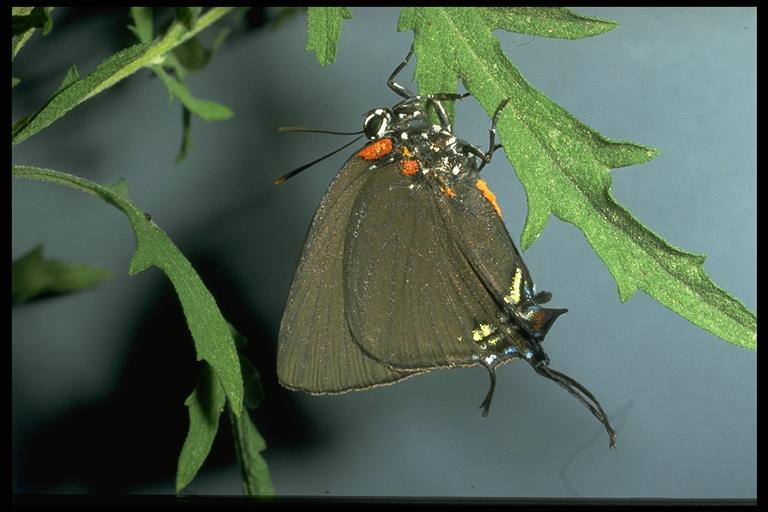
Cotton square borer or gray hairstreak, Strymon melinus Hübner (Lepidoptera: Lycaenidae). Photo by Drees.
Common Name: Cotton square borer
Scientific Name: Strymon melinus Hübner
Order: Lepidoptera
Description: Adults are common on flowers; caterpillars can feed on developing fruit such as cotton squares, hops and beans. Adults have a 1 to 1-1/4 inch wingspan and are dark gray above and slate or blue-gray below. They have a hair-like “tail” on each hind wing, along with a distinctive orange patch around a black spot on each surface. Caterpillar stages are reddish-brown or light green slug-like and are usually covered with short hairs (setae) making them appear velvety.
Most hairstreaks have fine, hair-like “tails” on their hind wings. When resting on plants, they move their wings back and forth, making the “tails” appear antennae-like, apparently to cause predators to attach this less vital part of their anatomy. One of
the largest (1-3/4 inch wingspan) colorful species is the great blue hairstreak, Atlides halesus Cramer, which has an iridescent blue patch of scales over a brown-black background on the upper surface of the wings, orange-red markings on the body and additional greenish iridescent markings around the tails. Caterpillars feed on mistletoe, Phoradendron sp. Caterpillars of some hairstreak species produce honeydew and are tended by ants. The Lycaenidae family is a large group of small butterflies, 65 occurring in Texas, and also include subfamily groups containing blues, coppers, and harvesters.

Blues (Lepidoptera: Lycaenidae), mating. Photo by J. Lee.
Blues are small butterflies, usually with upper wing surfaces colored blue to gray-brown and undersides marked with dark spots. One of the smallest butterflies is the pygmy blue, Brevidium exilis (Boisduval), with a wingspan of 1/2 to 3/4 inch. Caterpillars feed on white pigweed, Chenopodium album, and some other plants. Another group, the metalmarks (Riodinidae), contains small brown butterflies with pink metallic markings.
Life Cycle: Winter is spent in the chrysalis (pupal stage). Adult cotton square bors lay single, flattened eggs. On cotton, eggs are laid early in the spring. Eggs hatch in about 6 days. Caterpillars develop through several stages (instars) and feed over a period of about 20 days before forming a chrysalis. Adults emerge about 10 days later. There are 3 or more generations per year.
Habitat and Food Source(s): Caterpillars have chewing mouth parts and generally feed on flowers and immature fruits, seeds and buds of host plants that include 46 genera and 21 families of plants containing apple, blackberry, corn, cotton, lantana, legumes and strawberry. In cotton, caterpillars hollow out squares, producing round entrance and exit holes and tunnels lacking excrement (frass) associated with other species of cotton boll feeders, such as bollworms and tobacco budworms (Noctuidae).

Great purple hairstreak, Atlides halesus Cramer (Lepidoptera: Lycaenidae). Photo by Drees.
Pest Status: Caterpillars may damage cotton squares or buds of hibiscus, but are not common.
For additional information, contact your local Texas A&M AgriLife Extension Service agent or search for other state Extension offices.
Literature: Bohmfalk et al. 1982; Howe 1975; Neck 1996.